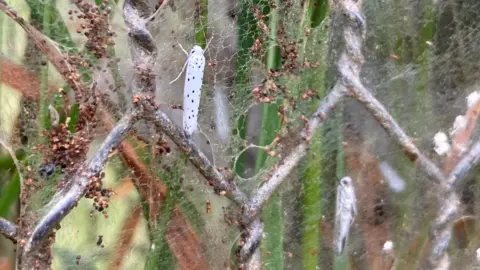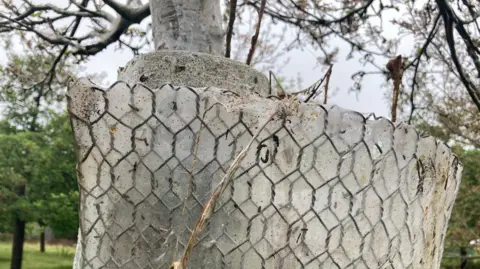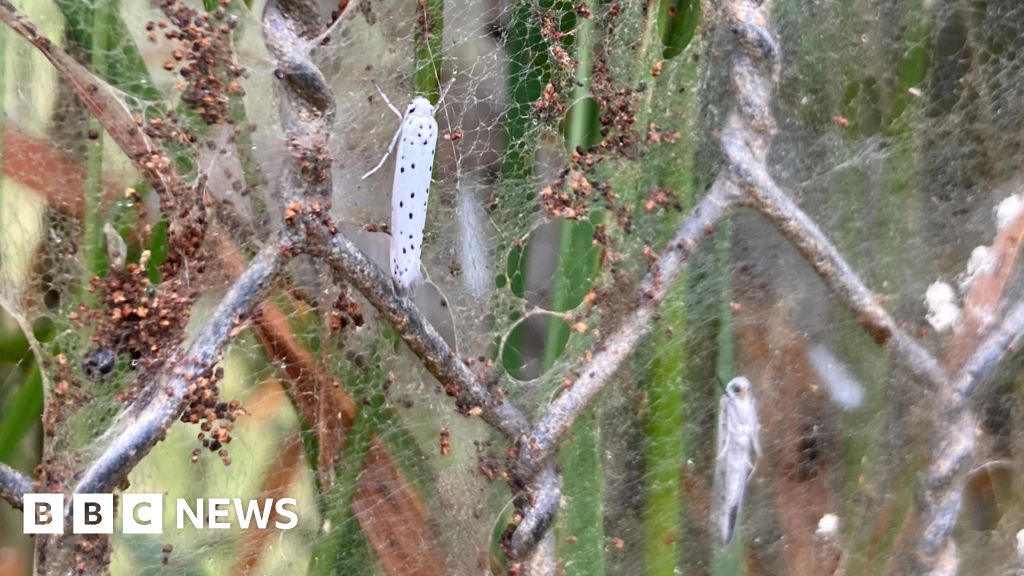By Matt Faulkner, BBC News, Somerset
 BBC
BBCAn orchard has been infested with “unprecedented” numbers of ermine moths.
The cider business, based near Kingsbury Episcopi in Somerset, has 15,000 trees and says at least half are currently infected.
Somerset Cider Brandy doesn’t use pesticides and says its only defence against the creatures is to buy ducks to eat the caterpillars.
An ermine moth is white with small black spots on the forewing, but the number of spots can vary.
They form ghostly webbing over the leaves to protect themselves from predatory birds while they feast.

Matilda Temperley is the managing director of Somerset Cider Brandy Company and says the weather is to blame.
“It’s the result of our climate breakdown and we’ve been seeing different things each year but this year it’s the apple ermine moth which is worse than anyone in living memory can say,” she said.
“By taking all the leaves off the trees there’ll be no harvest from them but if there’s another stress event it’s very likely the infected trees won’t survive.”
There’s a real worry about the amount of trees that could be affected at Burrow Hill Cider Farm.
 Fly Away Ballooning
Fly Away BallooningIt isn’t the flying moths that cause harm to the apple tree but, in spring, the trees are encased in thick cobwebs with eggs and larvae which can cause them stress and the caterpillars of the apple ermine moth, which hatch in summer, can cause defoliation.
It can be treated using pesticides, something that Matilda Temperley is against.
“We’ll pray for a really, really freezing cold winter.
“We are looking at potentially losing trees that have have been nurtured for the last three, four or five decades.”
She does have one solution should the pests return next year.
“We’ll buy ducks next year to at least catch the caterpillars when they’re on the ground.
“We’ll hope that this is an anomaly but it looks like it might not be because just the sheer volume of moths that will be flying around laying eggs in the next few weeks will lead to a thousand-fold of a problem next year.”

George Tordoff is a senior ecologist at Butterfly Conservation and a moth expert.
He said: “It’s interesting that apple ermine is present in such numbers, usually this species is only present as small webs even on unsprayed, non-commercial trees and doesn’t cause defoliation.
“The caterpillars feed in May and June and affected trees soon put on new growth afterwards, so the caterpillars are not thought to cause any long-term damage to the trees and don’t need chemical control.”
He also highlighted that the moths have an interesting way of avoiding being eaten by bats, they produce ultrasound when flying, which confuses the bats’ echolocation systems.


